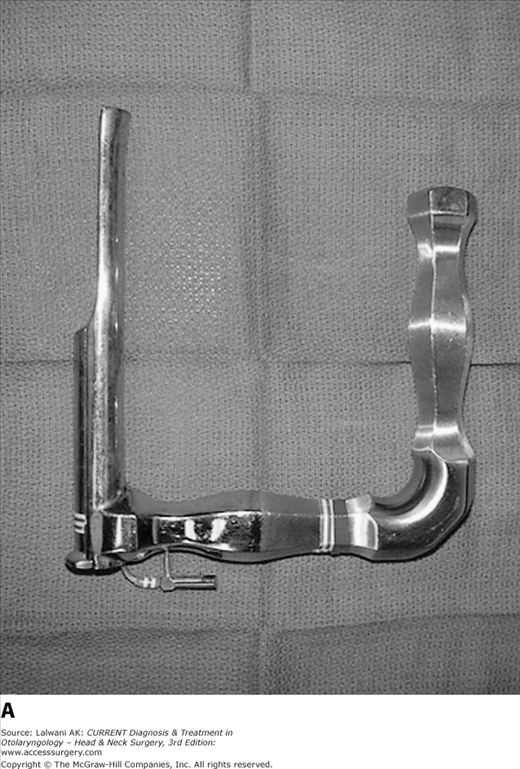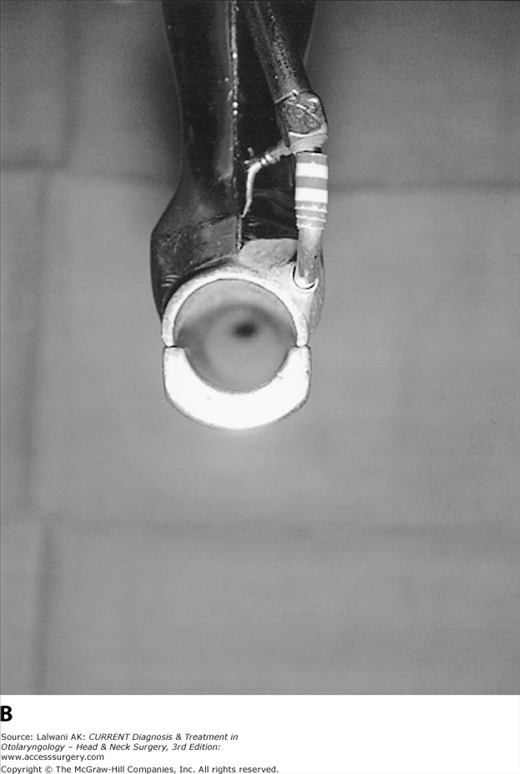Airway Management & Tracheotomy: Introduction
With airway obstruction, trauma, or elective surgery, control of the airway is the first priority that must be accomplished before any other intervention can proceed. In cases of a rapidly decompensating airway, particularly in pediatric patients or patients with airways that are difficult to manage, the otolaryngologist is frequently consulted to assist in patient airway management.
Patient Evaluation
Successful airway management must begin with a careful, thorough, and rapid evaluation of the airway. Healthy patients presenting with normal head and neck anatomy who undergo elective surgery represent relatively straightforward cases in which standard endotracheal intubation can provide an easy and secure airway. Patients presenting with upper airway obstruction must be evaluated quickly, efficiently, and accurately.
Physical examination is a key element in diagnosing upper airway obstruction. Stridor, or noisy respiration, is a hallmark symptom of upper airway obstruction. The timing of the stridor with respiration can frequently indicate where the obstruction lies. Inspiratory stridor normally results when the obstruction is at the larynx or above. Expiratory stridor usually indicates a more distal obstruction (eg, a tracheal obstruction). Biphasic stridor (ie, noise on both inspiration and expiration) may indicate a subglottic obstruction. The quality of the voice is also important. A muffled voice may reflect supraglottic obstruction, such as from the epiglottitis. A hoarse voice may indicate laryngeal involvement (eg, papillomas or tumors). A breathy or weak voice or cry may suggest vocal cord paralysis. Other signs of upper airway obstruction include suprasternal or substernal retractions, tachypnea, and cyanosis.
An accurate history is also critical in evaluating the airway and formulating the best plan to manage it. The physician should determine whether the obstruction occurred acutely or chronically. The age of the patient also helps in distinguishing the cause of the obstruction. Congenital airway anomalies (eg, laryngomalacia, choanal atresia, hemangioma, and tracheomalacia) and acute inflammatory causes (eg, croup and epiglottitis) are more common in children. In adults, tumors are a more common cause of obstruction. Trauma can cause airway obstruction, and this circumstance is usually easy to diagnose. However, it is important to carefully ascertain the mechanism and type of injury. Suspicion of laryngeal trauma may make conventional endotracheal intubation perilous because it can potentially result in a more compromised airway due to laryngotracheal separation. In these circumstances, the physician should consider performing a tracheotomy while the patient is awake. Similarly, massive maxillofacial trauma may preclude normal translaryngeal intubation; a flexible fiberoptic intubation or a tracheotomy while the patient is awake should be considered in these situations.
Treatment
Patients with difficult airways should be identified before the induction of anesthesia and intubation so that proper planning and communication between the anesthesiologist and the surgeon can be coordinated. A difficult airway is defined as a situation in which a conventionally trained anesthesiologist experiences difficulty with mask ventilation, endotracheal intubation, or both. In addition, the physician should be prepared for a potentially difficult airway or possible airway loss if both anesthesia induction and intubation are difficult. Both of these situations can be managed with a number of nonsurgical airway management techniques.
The first and most important task in nonsurgical airway management is to administer oxygen to relieve hypoxia. As the airway obstruction worsens, the physician may have to mask, ventilate, and provide a chin lift and jaw thrust to maintain a patent airway until a more definitive airway can be established. A helium–oxygen mixture of 80% helium to 20% oxygen can be used in some cases to improve ventilation temporarily until definitive control of the airway can be achieved. This mixture, known as heliox, depends on the decreased density of helium to deliver oxygen past the obstructing airway lesions.
Adjunctive medical therapy can be used to decrease upper airway obstruction if there is a component of soft tissue edema. Racemic epinephrine and epinephrine aerosols act as topical decongestants and can be given to try to decrease the edema. However, the effect is short in duration, and they may cause a rebound effect if used repeatedly. Consequently, their use is limited to the inpatient setting. The use of steroids in relieving upper airway obstruction can also be helpful, especially in cases in which edema or inflammation is present (eg, angioedema, croup, and adult supraglottitis). A suggested treatment is to administer methylprednisolone sodium succinate (125 mg IV) as a first dose and then continue with dexamethasone (8 mg IV every 8 hours) for several doses; methylprednisolone succinate has a more rapid onset of action than dexamethasone.
Oropharyngeal and nasopharyngeal airways are adjuncts to airway support that can be helpful in certain cases. For example, patients emerging from anesthesia or suffering from an altered mental state can have their airways supported with these devices until their mental status improves. Oropharyngeal airways prevent obstruction caused by a relaxed and prolapsed tongue. However, an incorrectly placed oropharyngeal airway can itself cause airway obstruction by pushing the tongue posteriorly into the hypopharynx. If placed in a patient who is still under light anesthesia, coughing and laryngospasm can occur. The traumatic insertion of nasal or nasopharyngeal airways can cause bleeding.
The definitive nonsurgical control of the airway is via translaryngeal intubation. This procedure should be considered the preferred method of establishing control of the airway in most cases, provided the patient’s condition is not so dire that an immediate airway is required, or in situations in which intubation is contraindicated (eg, laryngeal trauma or an obstructing tumor that makes intubation difficult). It is extremely important that a good airway history be obtained and a thorough examination be performed whenever possible before inducing anesthesia and performing an intubation.
A unique instrument familiar to otolaryngology surgeons is the Jackson sliding laryngoscope (Figure 38–1). This laryngoscope has better leverage and lighting compared with the anesthesiologist’s blades; the design of the laryngoscope makes it easier to manipulate past obstructing lesions or edematous soft tissue and suction can be used concurrently. Once the glottis is identified, an endotracheal tube is passed into the trachea and the laryngoscope’s floor can be slid out to facilitate removal of the laryngoscope. Frequently, the difficult airway can be managed with this technique.
Guided endotracheal intubation using a flexible fiberscope is an excellent technique for both routine and difficult airways. Placing an endotracheal tube with a fiberscope tube is particularly useful for an intubation in an awake, spontaneously breathing patient with a known or suspected difficult airway. Fiberoptic endotracheal intubations can be performed either via a nasal or an oral route. Once the route is chosen and anesthesia is achieved (topical or general), the endoscope is passed through the endotracheal tube, through the mouth or nose, and through the larynx into the trachea. The endotracheal tube is then advanced over the endoscope and into the trachea, using the endoscope as a “guidewire.” The endoscope is withdrawn after confirming the correct positioning of the endotracheal tube. Flexible fiberoptic intubation has limitations as well. Minimal trauma to these endoscopes may damage the delicate optics and distort the visual field. Bleeding and secretions can obscure the view and make visualization of the glottis extremely difficult. This technique may also be difficult in the uncooperative patient or in patients with inadequate topical anesthesia. Finally, introduction of the endoscope may actually cause complete airway obstruction in patients with severe intrinsic or extrinsic compression of the laryngeal or tracheal airways.
The laryngeal mask airway (LMA) is useful for establishing the airway in both routine elective cases and many emergency situations involving difficult airways. The LMA can be considered a hybrid between an endotracheal tube and a face mask (Figure 38–2). It can easily be inserted blindly into the hypopharynx; insertion is complete when resistance is felt. No neck movement or laryngoscopy is required. Once the mask is inflated, it fills the hypopharynx and covers the laryngeal inlet. Due to the LMA’s size and shape, it is not possible to pass it into the esophagus.
Stay updated, free articles. Join our Telegram channel

Full access? Get Clinical Tree




